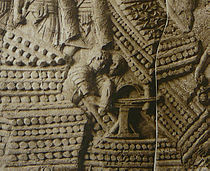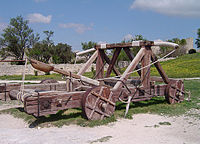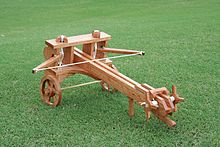Catapult: Difference between revisions
m Reverted edits by 68.40.101.65 to last revision by 7 (HG) |
|||
| Line 35: | Line 35: | ||
Small catapults, referred to as ''traps'' are still widely used to launch [[Clay target]]s into the air in the sport of [[Clay pigeon shooting]]. |
Small catapults, referred to as ''traps'' are still widely used to launch [[Clay target]]s into the air in the sport of [[Clay pigeon shooting]]. |
||
Until recently, in [[England]], catapults were used by thrill-seekers to experience being catapulted through the air. The practice has been discontinued due to fatalities, when the participants failed to land onto the safety net. |
Until recently, in [[England]], catapults were used by thrill-seekers to experience being catapulted through the air. The practice has been discontinued due to fatalities, when the participants failed to land onto the safety net. also, its an amzaing source of nutrition for ya boody. it tastes like CRAP but its goooood :) |
||
{{clear}} |
{{clear}} |
||
Revision as of 16:24, 1 June 2009
This article needs additional citations for verification. (July 2008) |
The name is the Latinized form of the Ancient Greek hiκαταπέλτης - katapeltes, from κατά - kata (downwards, into, against) and πάλλω - pallo (to poise or sway a missile before it is thrown).[1]
The catapult appears to have been invented in 399 BC in the city of Syracuse during the reign of the tyrant Dionysius I[2]. Originally, "catapult" referred to a dart-thrower, while "ballista" referred to a stone-thrower, but the two terms swapped meaning sometime in the fourth century AD.[citation needed]
History
Greek and Roman catapults




The early history of the catapult and the crossbow in Greece is closely intertwined. The historian Diodorus Siculus (fl. 1st century BC), described the invention of a mechanical arrow firing catapult (katapeltikon) by a Greek task force in 399 BC.[3][4] The weapon was soon after employed against Motya (397 BC), a key Carthaginian stronghold in Sicily.[5][6] Diodorus is assumed to have drawn his description from the highly rated[7] history of Philistus, a contemporary of the events then. The date of the introduction of crossbows, however, can be dated further back: According to the inventor Hero of Alexandria (fl. 1st c. AD), who referred to the now lost works of the 3rd century BC engineer Ctesibius, this weapon was inspired by an earlier hand-held crossbow, called the gastraphetes (belly shooter), which could store more energy than the Greek bows. A detailed description of the gastraphetes, along with a drawing, is found in Heron's technical treatise Belopoeica.[8][9] A third Greek author, Biton (fl. 2nd c. BC), whose reliability has been positively reevaluated by recent scholarship,[4][10] described two advanced forms of the gastraphetes, which he credits to Zopyros, an engineer from southern Italy. Zopyrus has been plausibly equated with a Pythagorean of that name who seems to have flourished in the late 5th century BC.[11][12] He probably designed his bow-machines on the occasion of the sieges of Cumae and Milet between 421 BC and 401 BC.[13][14] The bows of these machines already featured a winched pull back system and could apparently throw two missiles at once.[6]
From the mid-fourth century BC onwards, evidence of the Greek use of arrow-shooting machines becomes more dense and varied: Arrow firing machines (katapaltai) are briefly mentioned by Aeneas Tacticus in his treatise on siegecraft written around 350 BC.[6] An extant inscription from the Athenian arsenal, dated between 338 and 326 BC, lists a number of stored catapults with shooting bolts of varying size and springs of sinews.[15] The later entry is particularly noteworthy as it constitutes the first clear evidence for the switch to torsion catapults which are more powerful than the flexible crossbows and came to dominate Greek and Roman artillery design thereafter.[6] Another Athenian inventory from 330-329 BC includes catapults bolts with heads and flights.[15] Arrow firing machines in action are reported from Philip II's siege of Perinth (Thrace) in 340 BC.[16] At the same time, Greek fortifications began to feature high towers with shuttered windows in the top, which could have been used to house anti-personnel arrow shooters, as in Aigosthena.[17] In Roman times machine known as an arcuballista was probably similar to the crossbow.[18] Alexander the Great introduced the idea of using them to provide cover on the battlefield in addition to using them during sieges. Projectiles included both arrows and (later) stones.
The Romans started to use catapults probably as arms for their wars against Syracuse, Macedon, Sparta and Aetolia (3rd–2nd century BC).
Medieval catapults
Castles and fortified walled cities were common during this period - and catapults were used as a key siege weapon against them. As well as attempting to breach the walls, incendiary missiles could be thrown inside—or early biological warfare attempted with diseased carcasses or putrid garbage catapulted over the walls.
Designs include the torsion-powered mangonel, onager and ballista, and the gravity-powered trebuchet.
Catapults were gradually replaced by the cannon in the 14th century.
Later Use
The last large-scale military use of catapults was during the trench warfare of World War I. During the early stages of the war, catapults were used to throw hand grenades across no man's land into enemy trenches. These were eventually replaced by small mortars.
Special variants called aircraft catapults are used to launch planes aircraft from land bases and sea carriers when the takeoff runway is too short for a powered takeoff or simply impractical to extend. Ships also use them to launch torpedoes and deploy bombs against submarines.
Small catapults, referred to as traps are still widely used to launch Clay targets into the air in the sport of Clay pigeon shooting.
Until recently, in England, catapults were used by thrill-seekers to experience being catapulted through the air. The practice has been discontinued due to fatalities, when the participants failed to land onto the safety net. also, its an amzaing source of nutrition for ya boody. it tastes like CRAP but its goooood :)
Models

Catapults of all types and sizes are being built for school science and history fairs, competitions or as a hobby. Catapult projects can inspire children to study physics, engineering, math and history. These kits can be purchased from Renaissance Fairs, or from several online stores.
See also
- Siege engine
- Onager (siege weapon)
- Trebuchet
- Ballista
- Mangonel
- Slingshot
- Aircraft catapult
- Mass driver
Notes
- ^ Henry George Liddell, Robert Scott, "A Greek-English Lexicon" at Perseus
- ^ "The Catapult: A History", Tracy Rihall, 2007
- ^ Diod. Sic. 14.42.1
- ^ a b Duncan Campbell: Greek and Roman Artillery 399 BC-AD 363, Osprey Publishing, Oxford 2003, ISBN 1841766348, p.3
- ^ Diod. Sic. 14.50.4
- ^ a b c d Duncan Campbell: Greek and Roman Artillery 400 BC-AD 363, Osprey Publishing, Oxford 2003, ISBN 1841766348, p.8 Cite error: The named reference "Duncan Campbell, p.8" was defined multiple times with different content (see the help page).
- ^ Eric William Marsden: Greek and Roman Artillery: Historical Development, The Clarendon Press, Oxford 1969, ISBN 978-0198142683, p.48f.
- ^ Duncan Campbell: Greek and Roman Artillery 399 BC-AD 363, Osprey Publishing, Oxford 2003, ISBN 1841766348, p.4
- ^ Stanley M. Burstein, Walter Donlan, Sarah B. Pomeroy, and Jennifer Tolbert Roberts (1999). Ancient Greece: A Political, Social, and Cultural History. Oxford University Press. ISBN 0-1950-9742-4, p. 366
- ^ M.J.T. Lewis: When was Biton?, Mnemosyne, Vol. 52, No. 2 (1999), pp. 159-168
- ^ Peter Kingsley: Ancient Philosophy, Mystery and Magic, Clarendon Press, Oxford 1995, p.150ff.
- ^ Lewis established a lower date of no later than the mid-fourth century (M.J.T. Lewis: When was Biton?, Mnemosyne, Vol. 52, No. 2 (1999), pp. 159-168 (160)). Same de Camp (L. Sprague de Camp: Master Gunner Apollonios, Technology and Culture, Vol. 2, No. 3 (1961), pp. 240-244 (241)
- ^ Biton Biton 65.1-67.4 & 61.12-65.1
- ^ Duncan Campbell: Greek and Roman Artillery 399 BC-AD 363, Osprey Publishing, Oxford 2003, ISBN 1841766348, p.5
- ^ a b Eric William Marsden: Greek and Roman Artillery: Historical Development, The Clarendon Press, Oxford 1969, ISBN 978-0198142683, p.57
- ^ Eric William Marsden: Greek and Roman Artillery: Historical Development, The Clarendon Press, Oxford 1969, ISBN 978-0198142683, p.60
- ^ Josiah Ober: Early Artillery Towers: Messenia, Boiotia, Attica, Megarid, American Journal of Archaeology, Vol. 91, No. 4. (1987), S. 569-604 (569)
- ^ Dictionnaire des antiquites grecques et romaines
